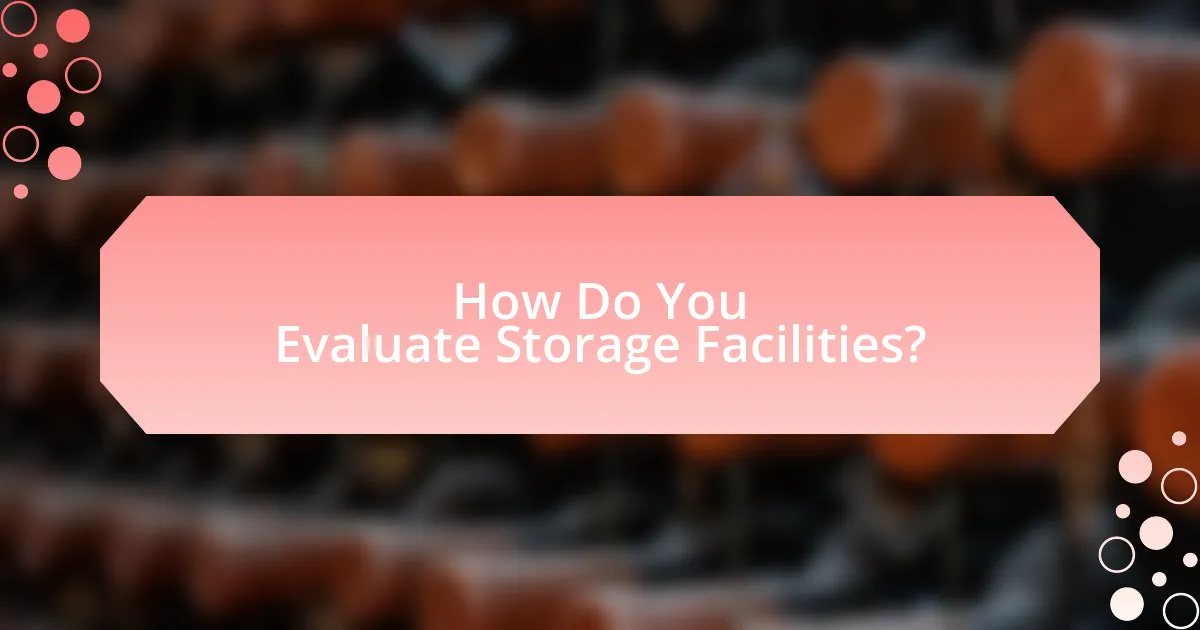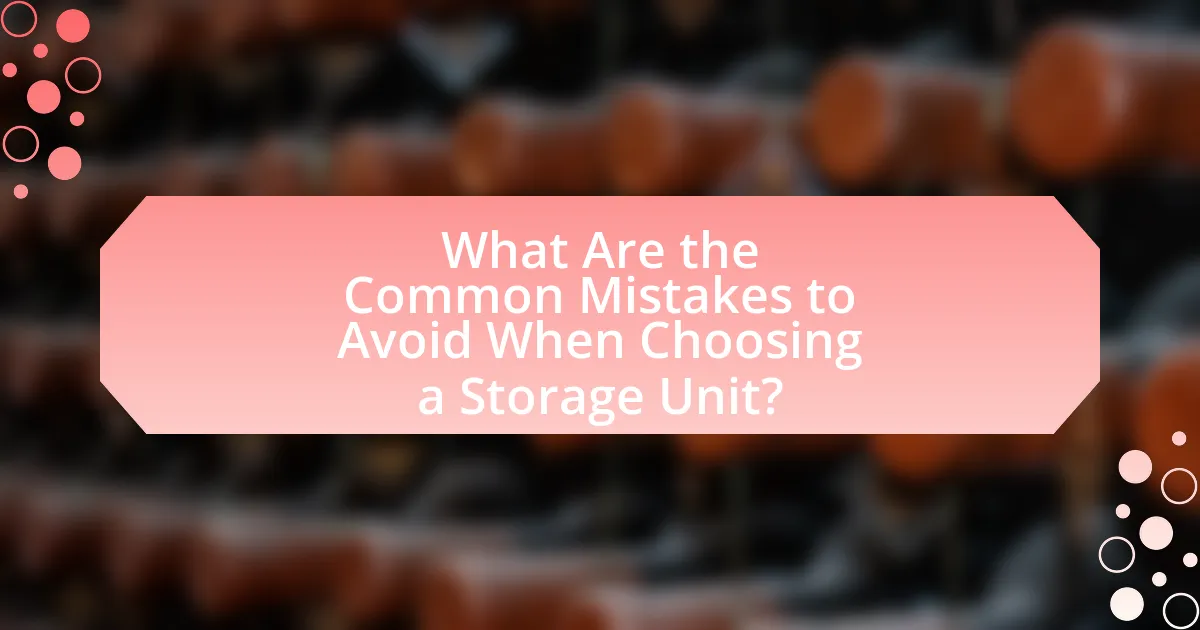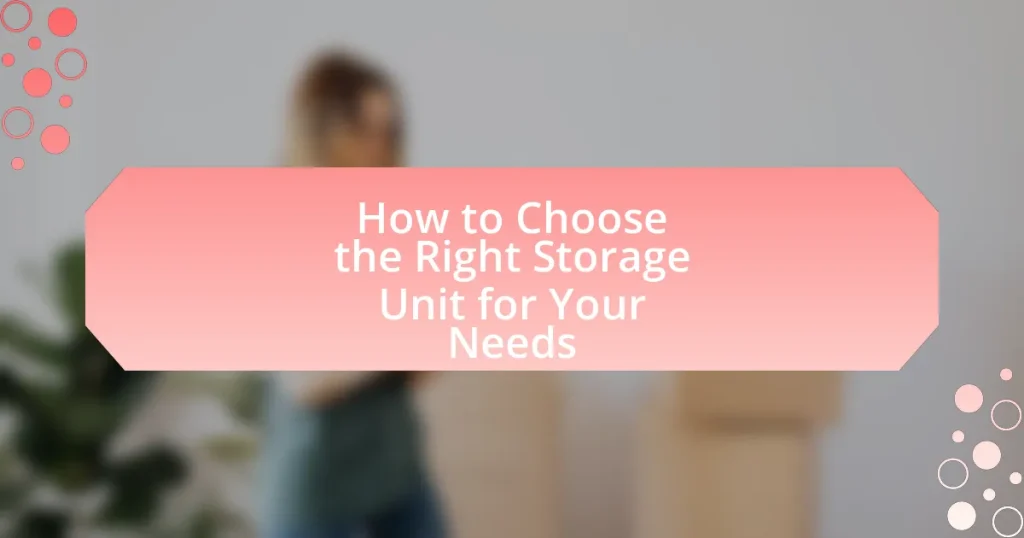Choosing the right storage unit involves several critical factors, including location, size, security, climate control, and cost. The article provides a detailed guide on how to assess your storage needs, determine the appropriate unit size, and evaluate different types of storage options, such as climate-controlled versus standard units. It also emphasizes the importance of security features, budgeting for additional costs, and avoiding common mistakes when selecting a storage facility. By following these guidelines, individuals can make informed decisions that best suit their storage requirements.
What Factors Should You Consider When Choosing a Storage Unit?

 |
|
When choosing a storage unit, consider location, size, security, climate control, and cost. The location should be convenient for access, ideally close to your home or business. The size must accommodate your belongings without wasting space; units typically range from small lockers to large garages. Security features, such as surveillance cameras and gated access, are crucial for protecting your items. Climate control is important for sensitive items, as it helps prevent damage from extreme temperatures or humidity. Lastly, compare costs among facilities to ensure you get the best value for your budget while considering any additional fees.
How do you determine the right size for your storage unit?
To determine the right size for your storage unit, first assess the volume and dimensions of the items you plan to store. Measure larger items like furniture and appliances, and estimate the number of boxes or bins you will need. For example, a 5×5 unit typically holds the contents of a small closet, while a 10×10 unit can accommodate the contents of a one-bedroom apartment. Additionally, consider future storage needs, as you may want extra space for additional items. Using these measurements and considerations ensures you select a unit that meets your current and potential future storage requirements.
What items do you plan to store, and how much space do they require?
I plan to store furniture, boxes of personal items, and seasonal decorations, which require approximately 100 to 150 square feet of space. Furniture typically takes up significant room, with an average sofa occupying about 30 square feet, while boxes can vary in size but generally require around 1 to 2 square feet each. Seasonal decorations, depending on quantity, may need an additional 10 to 20 square feet. Therefore, a storage unit of 10×10 feet or 10×15 feet would be suitable for these items.
How can you estimate the volume of your belongings?
To estimate the volume of your belongings, measure the dimensions of each item and calculate their volume using the formula: Volume = Length × Width × Height. This method allows for an accurate assessment of the space required for storage. For example, if you have a box that is 2 feet long, 1.5 feet wide, and 1 foot high, its volume would be 3 cubic feet. By summing the volumes of all items, you can determine the total volume needed for storage. This approach is practical and widely used in logistics and moving industries, ensuring that you select an appropriately sized storage unit.
What type of storage unit is best for your needs?
The best type of storage unit for your needs depends on the items you plan to store and the duration of storage. For example, climate-controlled units are ideal for sensitive items like electronics and antiques, as they maintain a stable temperature and humidity level. In contrast, standard drive-up units are suitable for general storage needs, such as furniture and boxes, providing easy access for loading and unloading. According to the Self Storage Association, 90% of storage users choose units based on accessibility and security features, indicating that these factors are crucial in determining the best fit for individual requirements.
What are the differences between climate-controlled and standard storage units?
Climate-controlled storage units maintain a consistent temperature and humidity level, while standard storage units do not offer such environmental controls. Climate-controlled units are ideal for sensitive items like electronics, antiques, and artwork, as they protect against damage from extreme temperatures and moisture. In contrast, standard units are suitable for more durable items that are less affected by environmental conditions. The effectiveness of climate-controlled units is supported by studies indicating that temperature fluctuations can lead to deterioration of certain materials, emphasizing their importance for specific storage needs.
How do different types of storage units cater to specific needs?
Different types of storage units cater to specific needs by offering tailored solutions for various items and circumstances. For instance, climate-controlled units are designed for sensitive items like electronics and antiques, maintaining a stable temperature and humidity to prevent damage. Drive-up access units provide convenience for individuals needing to load and unload heavy items quickly, making them ideal for moving or storing large furniture. Additionally, specialized units, such as vehicle storage, accommodate cars, boats, and RVs, ensuring they are protected from the elements. Each type of storage unit addresses unique requirements, enhancing user experience and satisfaction.
What is your budget for a storage unit?
The budget for a storage unit typically ranges from $50 to $300 per month, depending on factors such as size, location, and amenities. For instance, a small unit in a rural area may cost around $50, while a larger unit in a metropolitan area could reach $300 or more. This pricing reflects the average market rates observed across various storage facilities, ensuring that individuals can find options that fit their financial constraints.
How can you find affordable storage options without compromising quality?
To find affordable storage options without compromising quality, compare multiple storage facilities to assess their prices and services. Research shows that facilities offering competitive pricing often maintain high standards of security and cleanliness, which are crucial for quality. For instance, a study by SpareFoot found that 70% of consumers prioritize security features when selecting a storage unit, indicating that affordability does not have to come at the expense of quality. Additionally, reading customer reviews on platforms like Yelp or Google can provide insights into the experiences of others, helping to identify facilities that balance cost and quality effectively.
What additional costs should you consider when budgeting for a storage unit?
When budgeting for a storage unit, you should consider additional costs such as insurance, administrative fees, and potential late payment penalties. Insurance is often necessary to protect your belongings, with costs varying based on the value of items stored. Administrative fees may include one-time charges for setting up the rental agreement, which can range from $10 to $50. Late payment penalties can also add to your expenses, typically amounting to a percentage of the monthly rent or a flat fee, depending on the facility’s policies.
How Do You Evaluate Storage Facilities?

 |
|
To evaluate storage facilities, assess key factors such as location, security, accessibility, pricing, and customer service. Location is crucial; facilities should be conveniently situated to minimize travel time. Security features like surveillance cameras, gated access, and individual unit alarms enhance safety, which is vital for protecting stored items. Accessibility refers to the ease of reaching the facility and the availability of unit access hours, which should align with your schedule. Pricing should be competitive and transparent, with no hidden fees, and it’s beneficial to compare rates among similar facilities. Lastly, customer service quality can be gauged through reviews and direct interactions, ensuring that support is available when needed. These criteria collectively provide a comprehensive evaluation of storage facilities, ensuring they meet your specific needs.
What should you look for in terms of security features?
When evaluating security features for a storage unit, prioritize access control, surveillance systems, and environmental protections. Access control mechanisms, such as keypads or biometric scanners, ensure that only authorized individuals can enter the facility. Surveillance systems, including CCTV cameras, provide continuous monitoring, deterring theft and vandalism. Additionally, environmental protections like climate control and fire alarms safeguard stored items from damage. According to the Self Storage Association, facilities with robust security measures report lower incident rates, highlighting the importance of these features in protecting your belongings.
How do surveillance systems and access controls enhance security?
Surveillance systems and access controls enhance security by providing real-time monitoring and restricting unauthorized access to sensitive areas. Surveillance systems, such as cameras, deter criminal activity by increasing the likelihood of detection, while access controls, like keycards or biometric systems, ensure that only authorized individuals can enter specific locations. According to a study by the Security Industry Association, facilities with surveillance systems experience a 50% reduction in theft incidents, demonstrating their effectiveness in enhancing security.
What role do staff presence and facility maintenance play in security?
Staff presence and facility maintenance are critical components of security in storage units. The presence of trained staff deters criminal activity, as potential offenders are less likely to target facilities with visible personnel. Additionally, regular facility maintenance ensures that security systems, such as surveillance cameras and access controls, are functioning properly, which enhances overall safety. Studies have shown that facilities with active staff and well-maintained environments experience lower rates of theft and vandalism, reinforcing the importance of these elements in maintaining security.
How important is location when selecting a storage unit?
Location is critically important when selecting a storage unit. Proximity to your home or business can significantly affect convenience, accessibility, and cost. For instance, a storage unit located closer to your residence reduces travel time and transportation costs, making it easier to access your belongings when needed. Additionally, storage facilities in urban areas may charge higher rates due to demand, while those in suburban or rural locations might offer more competitive pricing. Therefore, considering location not only impacts the ease of access but also influences overall expenses associated with renting a storage unit.
What are the advantages of choosing a storage facility close to home?
Choosing a storage facility close to home offers convenience and accessibility. This proximity allows for easier access to stored items, reducing travel time and costs associated with transportation. Additionally, having a storage unit nearby can facilitate more frequent visits, making it simpler to manage belongings, whether for personal or business use. Studies indicate that individuals are more likely to utilize storage facilities that are within a short distance from their residence, enhancing overall satisfaction and usage rates.
How does accessibility impact your storage experience?
Accessibility significantly enhances the storage experience by ensuring that users can easily reach and utilize their storage units. When storage facilities are designed with convenient access points, such as wide driveways, ground-level units, and extended hours, customers can retrieve or store items without unnecessary hassle. Research indicates that facilities with improved accessibility often report higher customer satisfaction rates, as evidenced by a study from the Self Storage Association, which found that 70% of customers prioritize accessibility when selecting a storage unit. This focus on accessibility not only streamlines the process but also reduces the time and effort required for users, ultimately leading to a more efficient and positive storage experience.
What customer reviews and ratings should you consider?
Consider customer reviews and ratings that highlight the cleanliness, security, and accessibility of storage units. Reviews that specifically mention these aspects provide insight into the overall quality and reliability of the facility. For instance, a study by the Self Storage Association indicates that 85% of customers prioritize cleanliness and security when selecting a storage unit. Ratings that reflect consistent positive feedback in these areas are crucial for making an informed decision.
How can you find reliable reviews for storage facilities?
To find reliable reviews for storage facilities, utilize reputable review websites such as Yelp, Google Reviews, and Trustpilot. These platforms aggregate user feedback and provide ratings based on customer experiences, ensuring a broad perspective on the quality of services offered by various storage facilities. Additionally, check the facility’s official website and social media pages for testimonials and customer interactions, which can offer insights into their reliability and customer service.
What red flags should you watch for in customer feedback?
Red flags to watch for in customer feedback include consistent complaints about cleanliness, security issues, and poor customer service. When multiple customers mention that storage units are not well-maintained or that their belongings were damaged, it indicates a systemic problem that could affect your decision. Additionally, if feedback frequently highlights unresponsive staff or difficulty in accessing units, it suggests potential operational inefficiencies that could lead to a negative experience. Monitoring these patterns in customer reviews can help you identify storage facilities that may not meet your needs.
What Are the Common Mistakes to Avoid When Choosing a Storage Unit?

 |
|
Common mistakes to avoid when choosing a storage unit include not assessing space requirements, overlooking security features, and failing to read the rental agreement thoroughly. Assessing space requirements is crucial; many individuals underestimate the amount of space needed, leading to overcrowded units or the need for additional rentals. Security features are essential for protecting belongings; neglecting to check for surveillance cameras, gated access, and on-site management can result in theft or damage. Lastly, reading the rental agreement thoroughly is vital; hidden fees or unclear terms can lead to unexpected costs and disputes.
What pitfalls should you be aware of regarding contracts and agreements?
Common pitfalls regarding contracts and agreements include unclear terms, which can lead to misunderstandings and disputes. Ambiguities in language can result in different interpretations of obligations, making it essential to ensure that all terms are explicitly defined. Additionally, failing to read the entire contract can lead to overlooking critical clauses, such as cancellation policies or fees. Not considering the jurisdiction can also pose risks, as laws governing contracts vary by location, potentially affecting enforceability. Lastly, neglecting to document any verbal agreements or modifications can result in a lack of evidence in case of a disagreement.
How can hidden fees affect your overall costs?
Hidden fees can significantly increase your overall costs by adding unexpected expenses to your budget. For instance, if a storage unit advertises a low monthly rate but includes hidden fees such as administrative charges, insurance, or maintenance costs, the total amount paid can exceed initial estimates. Research indicates that consumers often overlook these fees, leading to an average increase of 20% to 30% in total costs compared to the advertised price. Therefore, understanding and identifying hidden fees is crucial for accurately assessing the true cost of storage solutions.
What terms should you clarify before signing a lease?
Before signing a lease, you should clarify terms such as the rental amount, lease duration, security deposit requirements, maintenance responsibilities, and any fees associated with late payments or early termination. These terms are crucial as they define the financial obligations and responsibilities of both the tenant and the landlord. Understanding the rental amount ensures you are aware of your monthly expenses, while clarifying the lease duration helps you plan your commitment. Security deposit requirements protect the property owner, and knowing maintenance responsibilities can prevent disputes later. Additionally, being informed about fees related to late payments or early termination can save you from unexpected costs.
How can overestimating your storage needs lead to wasted expenses?
Overestimating storage needs can lead to wasted expenses by causing individuals or businesses to rent larger storage units than necessary, resulting in higher monthly fees. For example, if a person anticipates needing a 10×20 unit but only requires a 10×10 unit, they may pay an additional 50% or more in rental costs without utilizing the extra space. This miscalculation not only increases ongoing expenses but can also lead to unnecessary costs associated with moving and maintaining more items than needed.
What strategies can help you accurately assess your storage requirements?
To accurately assess your storage requirements, conduct a thorough inventory of your items. This involves listing all items you plan to store, categorizing them by size and type, and estimating the space each category will require. For instance, a study by the Self Storage Association indicates that individuals often underestimate their storage needs by 30%, highlighting the importance of a detailed inventory. Additionally, consider future storage needs by accounting for potential acquisitions or seasonal items, ensuring that your chosen storage solution accommodates growth.
How can you avoid renting more space than necessary?
To avoid renting more space than necessary, accurately assess your storage needs by taking inventory of the items you plan to store. This involves categorizing items, measuring their dimensions, and estimating the total volume required. Research indicates that 30% of rented storage space is often unused, highlighting the importance of precise evaluation. By calculating the total space needed based on your inventory, you can select a storage unit that fits your requirements without excess capacity.
What tips can help you make the best choice for your storage needs?
To make the best choice for your storage needs, assess the size and type of items you plan to store. Understanding the volume and dimensions of your belongings will help you select a unit that accommodates them without wasting space. Additionally, consider the location of the storage facility; a nearby location can save time and transportation costs. Evaluate the security features offered, such as surveillance cameras and gated access, to ensure your items are protected. Finally, compare pricing and rental terms among different facilities to find the best value for your budget.
How can you effectively compare different storage options?
To effectively compare different storage options, evaluate key factors such as cost, size, accessibility, security features, and location. Cost analysis involves examining monthly rental fees and any additional charges, while size comparison requires assessing the volume of items to be stored against the dimensions of available units. Accessibility includes checking hours of operation and ease of access to the storage facility. Security features should be scrutinized, including surveillance systems, gated access, and individual unit locks. Lastly, location is crucial; a facility closer to your home or business can save time and transportation costs. By systematically analyzing these factors, you can make an informed decision that best meets your storage needs.
What best practices should you follow when selecting a storage unit?
When selecting a storage unit, prioritize location, size, security, and climate control. A convenient location reduces travel time and costs, while the right size ensures your belongings fit without wasted space. Security features, such as surveillance cameras and gated access, protect your items from theft. Climate control is essential for sensitive items, as it prevents damage from extreme temperatures and humidity. According to the Self Storage Association, 90% of storage facilities offer some form of security, highlighting its importance in the selection process.


